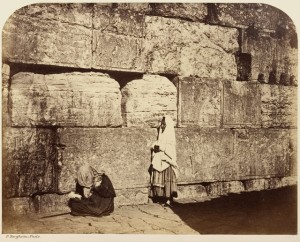 Placing Notes Into Cracks of Western Wall
Placing Notes Into Cracks of Western Wall
The practice of placing prayer notes into the cracks and crevices of the Western Wall began over 300 years ago. The earliest account of this practice is recounted by the Munkatcher Rebbe and is recorded in Sefer Ta’amei Haminhagim U’mekorei Ha-dinim. The story involves Rabbi Chaim ibn Attar, the Ohr Hachaim, in Morocco. A certain man came to him in great distress after he had become so destitute that he couldn’t afford to buy food for his family. The Ohr Hachaim wrote him an amulet in Ashuri script on parchment and instructed the man to place it between the stones of the Western Wall. Another story is told involving a student of the Ohr Hachaim who planned to emigrate to Jerusalem from Morocco. The Ohr Hachaim instructed him to place a note in the wall upon his arrival. The pupil, who later became famous as the Chida, attributed his personal success to the note, which read, “Dear God, please let my student Azulai become successful in Israel.”
The rationale behind placing prayer notes in the Wall has been traced to the Midrashic teaching that the Divine presence has never moved from the Western Wall, and the Kabbalistic teaching that all prayers ascend to Heaven through the Temple Mount, which the Western Wall abuts.
Source: Wikipedia; Sperling, Avraham Yitzchak (1999). Sefer Tamei Ha-minhagim U’mekorei Ha-dinim; Inyanei Hilula D’Rashbi, p. 270. Jerusalem: Shai Le-morah Publishing.; Simmons, Rabbi Shraga. “What is the Origin, Process and Reason Behind Placing Notes in the Western Wall?” about.com; Exodus Rabbah 2:2.; Pirke De-Rabbi Eliezer 35: “Anyone who prays in this place in Jerusalem, it is as if he prayed before the Throne of Glory, for the gate of heaven is there, open to hear all prayers”; Simmons, Rabbi Shraga. “Six Reasons Why The Wall Is Holy.”
